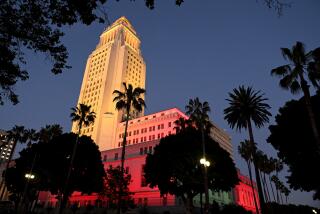The Mayor and the Congress Find Each Other
- Share via
The phone rang at my desk in the newsroom late Monday morning.
It was Mayor Richard J. Riordan on his speaker phone, with his new deputy mayor, Robin Kramer, who is in charge of sharpening the mayor’s image and improving his political relations.
Riordan explained that he had just finished a meeting with nine members of Los Angeles County’s congressional delegation and he felt it was a real breakthrough. He wondered if I wanted to write something about it.
I was intrigued. Although members of Congress have brought a lot of federal money into the area, especially when aerospace was hot, they generally keep themselves remote from the workings of City Hall, careful not to soil their skirts and suits with the muck of local politics.
I was surprised that some of them knew where City Hall was and genuinely shocked that they had braved the terrors of Downtown Los Angeles to drive there for a meeting with the mayor.
But as Riordan described the agenda of his meeting--crime and economic recovery--I could see why the session was important. It reflected a growing realization among elected officials that the Southland’s deep and complex troubles transcend the artificial boundaries of political subdivisions such as cities, counties and congressional districts.
So I crossed the intersection of 1st and Spring Streets, climbed the front steps of City Hall, walked through the grand rotunda, and turned right into the mayoral suite.
*
Riordan told me his meeting with the congressional group ranged from crime prevention to obtaining the Republican and Democratic national conventions for Los Angeles in 1996. By chance, President Clinton called Riordan at the beginning of the meeting to announce that Los Angeles had been given a $4-million law enforcement grant that Riordan said will permit the hiring of 54 more cops.
The issue that showed the value of the meeting--and the obstacles the participants face--was the proposed Alameda Corridor, a high-speed freight train line designed to connect the Los Angeles and Long Beach harbors with the freight yards in Downtown Los Angeles.
I later talked to several of the participants in the rare mayoral session. Everyone in the room, they said, backed the project, which they believe will stimulate the economy of southeastern Los Angeles County, hard hit by the aerospace decline. Supporters envision industrial parks and export and import warehouses built along the train line. They figure that these facilities, along with proposed harbor expansions will create thousands of jobs.
But the congressional representatives told Riordan not to count on a hoped-for $800 million in federal aid. Creative alternatives are needed, they said. Rep. Walter Tucker, a Compton Democrat, offered one--a bill giving a tax break for bonds to finance the project.
Reps. Jane Harman and Lucille Roybal-Allard said they spoke of the importance to their districts of the corridor project, along with proposed expansions of the Long Beach and Los Angeles harbors. So did Rep. Steve Horn of Long Beach.
The projects certainly are important for these beleaguered constituencies, and for Tucker’s.
Harman represents the South Bay, with its concentration of unemployed aerospace workers. Allard-Roybal’s district includes the fading factory neighborhoods south of Downtown Los Angeles, along with the old working-class cities of Huntington Park, South Gate, Bell, Bell Gardens, Commerce, Vernon, Maywood and Cudahy. Tucker speaks for the industrial areas stretching from Watts to Wilmington on the harbor. Horn’s Long Beach has been hurt by major aerospace layoffs.
*
Veterans said it was the first time in their memory that a mayor had met with the L.A. congressional delegation in City Hall. It showed how things had changed since the height of Tom Bradley’s reign, when the county was booming.
Democrat Bradley used to fly to Washington and meet with L.A. Democratic congressional powers and with those he’d known from his years as a party leader. He was a real success in bringing back appropriations, as we can see today from the subway and other rail projects.
Bradley “had excellent relations with many of us,” said veteran Rep. Howard Berman, who participated in the meeting with Riordan. But Riordan reached out to the entire delegation, not just to powerful committee chairmen. Among the participants, for example, were Democrat Anthony Beilenson and Republican Carlos Moorhead, who have never been heavily identified with City Hall. “This was the first time the top guy and his staff wanted to work with the L.A. delegation as a whole,” Berman said.
It shows how Republican Riordan, faced with problems that extend far beyond the boundaries of his city, understands that he must deal with politicians from both parties, and from many places.
More to Read
Get the L.A. Times Politics newsletter
Deeply reported insights into legislation, politics and policy from Sacramento, Washington and beyond. In your inbox twice per week.
You may occasionally receive promotional content from the Los Angeles Times.










